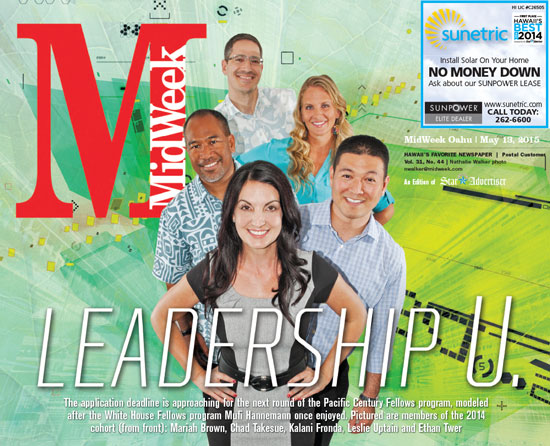Leadership U.

Members of the Pacific Century Fellows 2014 cohort (from front): Mariah Brown, owner, Da Kitchen Restaurants; Chad Takesue, partner, Locations LLC; Kalani Fronda, Kamehameha Schools senior asset manager; Leslie Uptain, director of philanthropy, The Trust for Public Land; Ethan Twer, associate, Architects Hawaii, and Mufi Hannemann, founder, PCF. PHOTOS BY NATHALIE WALKER
The application deadline is approaching for the next round of the Pacific Century Fellows program, modeled after the White House Fellows program Mufi Hannemann enjoyed.
When professional athletes like LeBron James talk about preparing for the playoffs, they speak of putting blinders on to give themselves a singular focus to achieve their goal of a championship.
While this is evidently a good plan in sports, in business and as a community contributor, a broader view is best. This is where Pacific Century Fellows come in, as a sort of blinder-removal service.
Founded in 1997 by Mufi Hannemann in his pre-mayor days, PCF was envisioned as an island version of the White House Fellows program in which Hannemann participated, working for Vice President George H. W. Bush.
The yearlong program takes leaders from all walks of life, from educators to architects, business people to military personnel, and engages them in the engines that make our state run, and allows them to question and learn from leaders in each field.
“We want fellows who are involved in the community, not just doing well and on the upward climb in their company, but who have already started to be involved in nonprofits, a leader who knows how to give back,” says Hannemann.
The trips run the gamut of the glorious, such as landing on and spending a day on an China, to the banal, like a tour of the landfill or wastewater treatment plant. But each activity is purpose-driven to open the eyes of young local leaders about what it takes to have a society, as can be attested by this year’s graduates.
“Before, I would be reading a story in the newspaper and I couldn’t really make a connection with the article or the company, and now it is my friends who are at the forefront of current events,” says Ethan Twer, an associate with Architects Hawaii Ltd.
Insider knowledge to what is behind the headlines is the key, understanding that there are real people doing those jobs keeping the community functioning.
“It is so easy to get caught up in your world,” says Leslie Uptain, director of philanthropy for Trust for Public Land. “To be put with people from all different sectors for an entire year with in-depth, high-level access, and to be able to question those leaders, brainstorm solutions and hear each other’s experiences, that inspired me.
“It is an opportunity for up- and-coming leaders to learn about the challenges and opportunities facing the state of Hawaii, with the purpose of, as we become Hawaii’s future leaders, that we have that background information to fall back on to consider as we make decisions for our state and our community.”
It is this access that had fellow graduate Chad Takesue, a Realtor for Locations LLC, wishing that the program was a requirement for everyone in a public office.
“During an election year, you understand the issues better because you have seen both sides and make your own decisions, you are more informed,” says Takesue, who recently was named president of the nonprofit Locations Foundation. “You wish every leader went through this process. Then they would know more and make better decisions, and whether you agree with them or not, you know they went through the due diligence, which is all you can ask for as a citizen.”
An example can be seen in the contentious issues facing the farming community today, pitting big businesses like Monsanto against little farmers trying to feed the community.
“You get to see both sides of every issue. We spent a day at Monsanto and with Dean Okimoto from ‘Nalo Farms,” says Uptain. “It allows you to create a better-versed opinion based on facts rather than media, impressions and fear. Every field trip had that — dual purpose, dual opinions from leaders that you got to question.”
Another often-maligned entity in the Islands is the military, and PCF got to see them do their job on one of the most impressive pieces of military hardware ever created, the USS Ronald Reagan aircraft carrier.
During RIMPAC, the group was flown an hour out to the carrier in a windowless plane, where they landed on its deck Top Gun-style, complete with the hook-and-cable braking method. And after 24 hours with the 5,000 sailors onboard, they came away with a very different opinion than some of them had landed with that day.
“Watching those sailors doing their work — everybody so young and so competent, and I haven’t always had the most positive view of the U.S. military, especially living here in Hawaii,” says Uptain, “but for me it was such an eye-opening and heart-opening experience to really see them and appreciate what they do day-to-day.”
Creating connections with this large sector of our community is important, even though many of them rotate out every couple of years.
“We encourage the military to be a part of it, and we know military folks will come and go, but the military as an institution is always going to be a part of our state, and we benefit from having them in a class. It is a healthy interaction,” says Hannemann.
The program sends the fellows on one Neighbor Island trip, though they can opt for more, as this class did, choosing to visit Lanai to watch its growth, Maui to meet the mayor, Molokai to explore Kalaupapa and Kahoolawe to get their hands dirty.
They spent three days helping to restore the aina on the Target Isle, removing rocks, planting native Hawaiian foliage and experiencing the spiritual aspect of the piko of our home state.
“Not only did we learn about what was going on there,” says Kalani Fronda, senior asset manager with Kamehameha Schools, “but we got to experience what the restoration of the land is going through, the healing it is going through and how the aina takes care of us. It helped us understand how spiritual and important that place is for the entire Island chain.”






